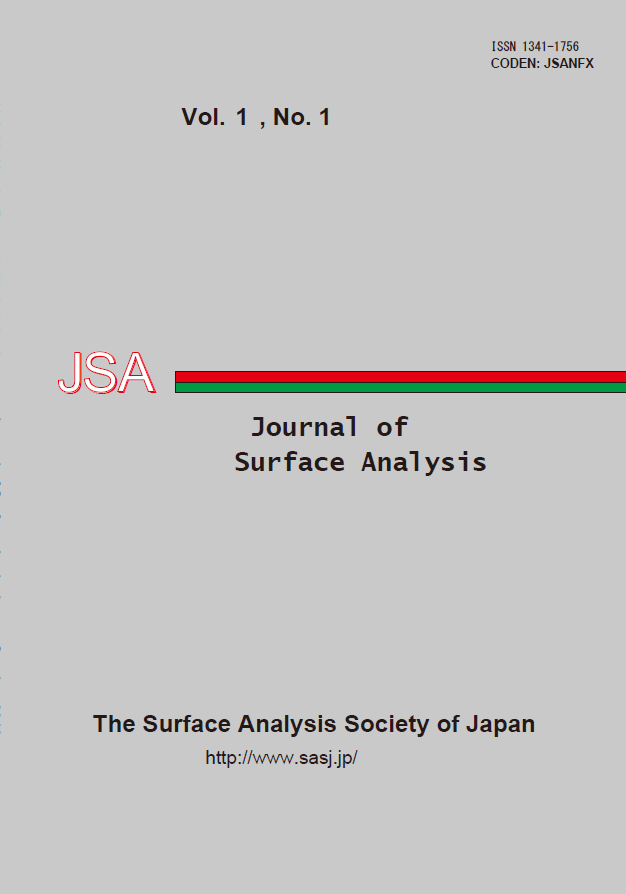All issues

Volume 23 (2016)
- Issue 3 Pages 138-
- Issue 2 Pages 73-
- Issue 1 Pages 2-
Volume 23, Issue 1
Displaying 1-3 of 3 articles from this issue
- |<
- <
- 1
- >
- >|
Review
-
Takaya Satoh, Makiko Fujii, Jiro Matsuo2016 Volume 23 Issue 1 Pages 2-10
Published: 2016
Released on J-STAGE: March 01, 2017
JOURNAL FREE ACCESSDevelopments of matrix-assisted laser desorption/ionization (MALDI) have been expanded the application field of organic mass spectrometry. Recently, imaging mass spectrometry (IMS), which enables to visualize localization of specific organic compounds, is improved in biological field. It is also expected to apply in industrial field as surface analytical tools; however, the application is still limited. In the industrial field, the probing depth from the sample surface is important as well as lateral resolution. In this paper, we have studied laser desorption/ionization (LDI-IMS) for using two-layered sample made by organic light emitting diode materials. We also studied difference between solvent-base matrix-assisted LDI-IMS (MALDI-IMS) and solvent-free surface-assisted LDI-IMS (SALDI-IMS) using silver deposition method using two-layered sample made by Irganox 1010 and Irganox 3114.View full abstractDownload PDF (770K)
Letter
-
Shin-ichi Iida2016 Volume 23 Issue 1 Pages 11-18
Published: 2016
Released on J-STAGE: March 01, 2017
JOURNAL FREE ACCESSThe applications of depth profile analyses in TOF-SIMS are expanding, because TOF-SIMS has high sensitivity for elemental as well as molecular species. Sputter depth profiling is commonly used to obtain depth profiles. However, if the sample has a complex structure or composition, the result will be quite difficult to understand. The authors have tried the cross-section imaging methods to know the accurate elemental or molecular depth distributions for such kinds of samples. In this article, in order to acquire the cross-section images from organic/inorganic hybrid materials by using FIB-TOF-SIMS, the possibility of removal of FIB induced damage layer by Ar-GCIB was investigated. The author applied this result to the organic/inorganic multilayer sample analysis, and it was shown that the cross-section imaging of an organic material underneath the metal layer was possible.View full abstractDownload PDF (714K)
Technical Report
-
Nobuyuki Sugiyama, Yoko Yoshida, Takanori Sugimoto, Toshiaki Nakao, Hi ...2016 Volume 23 Issue 1 Pages 19-29
Published: 2016
Released on J-STAGE: March 01, 2017
JOURNAL FREE ACCESSWe analyzed a hot-dip galvanized steel surfaces after combined corrosion cyclic tests by X-ray absorption fine structure (XAFS), Scanning Electron Microscope, X-ray Photoelectron Spectroscopy, and X-ray diffraction in order to reveal the difference between XAFS analysis and the other surface analysis techniques. We evaluated the changes of Zn, and Zn-Al-Mg alloy hot-dip galvanized steel surfaces before, during, and after combined corrosion cyclic tests with those analytical techniques. These results shows that it is possible to analyze the valence state by XAFS, which is not by SEM-EDX, and obtain the information ranging from several nanometers to a few micrometers in thickness by changing the measurement technique of XAFS, as necessary.View full abstractDownload PDF (1242K)
- |<
- <
- 1
- >
- >|